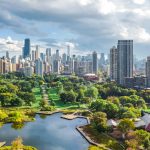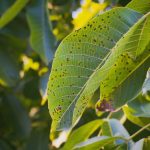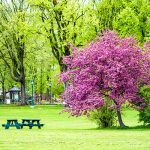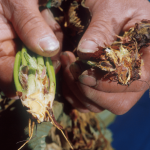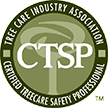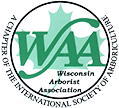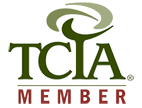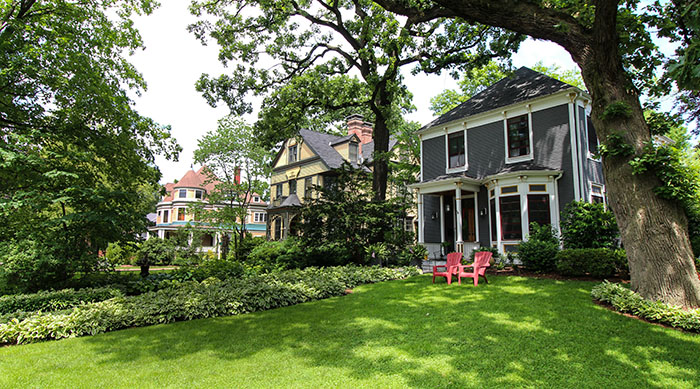
Learn how to prevent, identify and treat Tree Blight in your Chicagoland home
We have returned this week with our series on the common tree diseases and insect pests in Illinois to investigate a set of tree diseases that can attack the leaves, branches, and fruit of many different types of trees: tree blight. Tree blight refers to several similar contagious tree diseases that can attack hundreds of different trees that are native to Illinois from fruit trees to pines. These diseases can be caused by bacteria or fungi and they generally cause discoloration and wilting of leaves and fruit. Extreme cases of tree blight can cause branches to die and even make removal necessary.
Whether started by a fungus or bacteria, it is generally spread to vulnerable leaves and fruit by insects. It is also possible for it to be spread by wind and rain. Once the bacteria or fungus enters the tree, it makes its way to the vascular system where it can spread throughout the tree and eventually to the roots. Infected leaves, fruit, and branches may have a dark colored ooze emerging from them that will cause the leaves and fruit to wilt and discolor. Tree blight diseases can affect a wide range of trees native to Illinois including fruit trees like apples, crabapples, and pears, pine trees, maple trees, oaks, dogwoods, elms, and more.
In this guide, we will take a look at tree blight in general as well as specific types of tree blight diseases that can attack different types of trees. This includes signs of tree blight, how these diseases come to affect trees, and tree blight treatment and control. Our professional arborists at Hendricksen Tree Care can help provide effective care for your trees that include tree care and maintenance to prevent and treat tree blight and other tree diseases. It is important to contact our professional arborists at Hendricksen Tree Care if you believe your trees are affected by tree blight because ignoring the signs of these diseases can result in significant damage and even the removal of your trees.
Life Cycle of Tree Blight
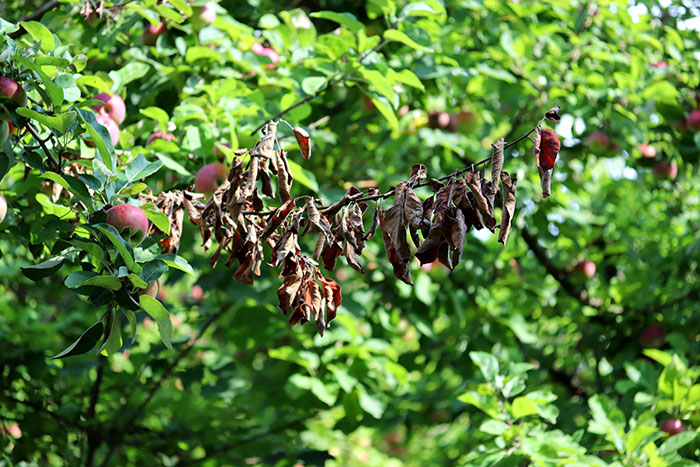
Tree Blight killing the branch of an apple tree
In many cases involving tree blight diseases, the bacteria or fungus that causes the disease overwinters in the cankers, branches, or trunks of already infected trees. When the spring arrives, the bacteria or fungus multiplies in the wet conditions and an ooze will secrete through natural openings in the bark. This ooze attracts insects which then makes them carriers of the bacteria or fungus. These insects, mainly pollinating insects, will carry the bacteria or fungus to the leaves, fruit, and flowers of healthy trees where it will multiply before penetrating the tree.
Pollinating insects are the main vectors for various forms of tree blight, but the bacteria or fungus can also be spread by wind, rain, and even pruning if the tools used for tree trimming are not sanitized between uses.
The bacteria or fungus can quickly infect and spread through an infected tree, especially during wet or humid weather conditions. The pathogen can enter the tree through openings in the bark and form cankers on the affected branches. These branches can become girdled by the cankers and a black or brown ooze will come out of the branches and cause the leaves, flowers, or fruit to become discolored and wilted. Eventually entire branches can die.
As the pathogen enters the tree, it finds its way to the vascular system where it can spread throughout the tree and makes its way to the main trunk and root system. When the root system becomes affected, the entire tree can become compromised, and it will likely need to be removed.
Signs and Symptoms of Tree Blight
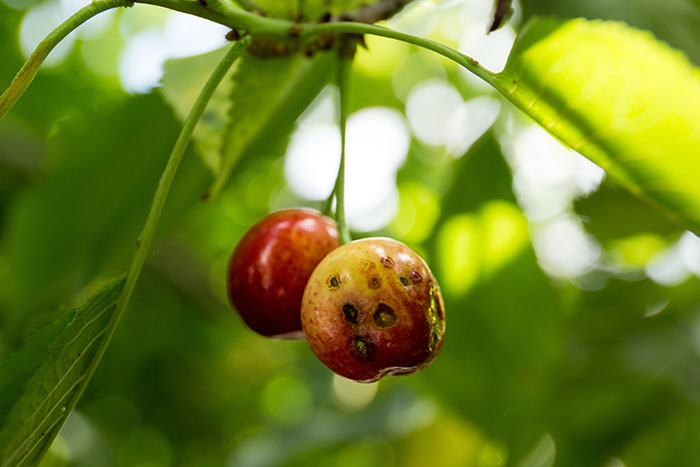
Tree Blight on the fruit of a cherry tree
Various forms of tree blight can disrupt the flow of water within the tree and cause an ooze secretion that results in wilting and discoloration of leaves, fruit, and flowers and dieback of the branches. It is important to check for the following symptoms if you believe your trees are affected by tree blight:
- Bacterial ooze: This ooze is a white or tan liquid produced by the bacteria that may be seen excreting from the affected twigs, branches, and trunk. The ooze will turn darker in color, typically black or brown, when it is exposed to oxygen.
- Wet and wilted flowers: On flowering trees, the flowers will appear wet and then become wilted. As the flowers droop and shrivel, they turn brown and then black in color. The flowers will not fall from the branch and instead stay attached through the growing season.
- Infected fruit: On fruiting trees, the fruit can be affected as they may turn brown or black and lose all moisture. In some cases, tree blight can prevent fruiting trees from producing edible fruit at all.
- Wilting leaves: The leaves on infected twigs and branches will bend backwards and wilt, first turning a grayish-green color and then brown or black. The leaves often appear scorched, hence the name tree blight, and they will remain on the tree.
- Cankers: Cankers are areas of dead bark that may form on the trunk of infected branches. They may appear brown or black in color and they can girdle the affected branch and stunt its growth.
- Sunken bark: The bark of an infected tree may sink inward and crack, making it easy to peel off.
- Stained sapwood: The sapwood under the bark can form lesions from the bacteria ooze that can cause brown stains to appear.
Types of Tree Blight
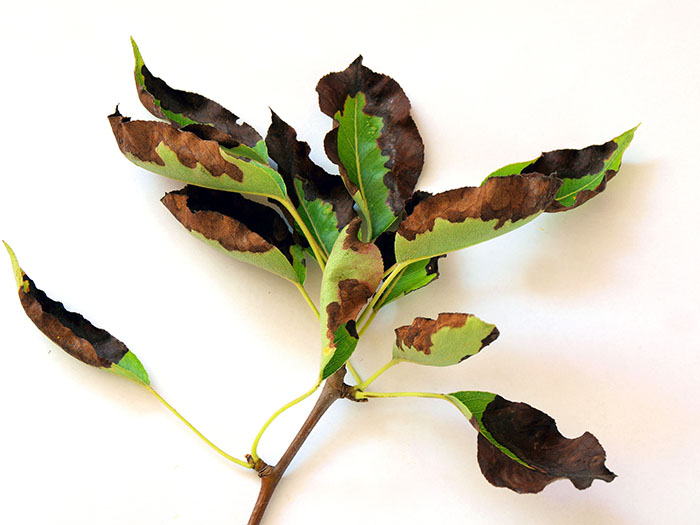
Fire Blight, a type of Tree Blight, attacking the leaves of an otherwise healthy tree
Tree blight is a classification of tree diseases that have similar symptoms and attack different types of trees. Most types of tree blight are caused by bacteria but there are some that can be caused by a fungus as well. The following are the most common types of tree blight:
- Fire blight: Fire blight is a type of tree blight that specifically attacks fruiting trees such as apples, crabapples, pears, and more. The spread and symptoms of fire blight are consistent with those described above.
- Diplodia blight: Diplodia blight is a tree blight disease that specifically affects conifers such as pine trees and evergreens. This disease can cause browning of the needles and stop the growth of new shoots.
- Dothistroma blight: This is another type of disease that affects pine trees, specifically pine tree needles. Serious cases can result in the death and removal of the tree.
- Anthracnose: Anthracnose is a fungal disease that attacks hardwood trees like dogwoods, oak trees, and sycamore trees. The leaves of affected trees may have dark or dead spots.
- Verticillium wilt: Verticillium wilt is a type of tree blight caused by a fungus that attacks various types of maple trees. The fungus that causes this disease is found in the soil and it works its way up the tree to cause brown, wilted leaves and branch dieback. Affected trees often have to be removed.
- Dutch elm disease: Dutch elm disease is caused by a fungus and can result in serious damage to elm trees. The fungus clogs the vascular system of affected trees and disrupts the flow of water which results in wilting of the leaves and branch dieback.
Tree Blight Treatment and Management
Many tree blight diseases cannot be cured, but it is possible to treat trees affected by blight if you react early enough. Tree blight diseases tend to attack branches first before they reach the trunk and root system which means there is time to save the tree. If you notice any signs of tree blight on your trees, you need to call our tree care professionals at Hendricksen Tree Care immediately to diagnose and treat your trees.
The following tips can help you prevent and control tree blight:
- Tree trimming: If you find signs of tree blight among the leaves, flowers, or fruit of your trees, the most effective way to control it is to prune the affected branches. Removing affected branches quickly can prevent the disease from spreading and save the rest of the tree. If you trim your trees yourself, make sure you remove the branches to prevent the disease from spreading and sterilize your equipment with a water and bleach solution. You can also call a professional for tree trimming services.
- Fungicidal applications: It is possible to protect leaves, flowers, and fruit with fungicidal applications. It is best to have a professional apply a fungicide.
- Remove dead leaves and branches: Removing any dead plant materials is a preventative measure as the types of fungus that cause tree blight thrives in dead materials.
- Fertilization and watering: It is important to avoid overwatering susceptible trees because the bacteria that causes tree blight multiplies quickly in wet conditions. You should also avoid applying too much nitrogen-based fertilizer.
- Plant tree blight resistant trees: The best thing you can do to avoid tree blight is plant trees that are resistant to tree blight including magnolia trees and Japanese maples.
Tree Care and Maintenance from Hendricksen Tree Care
All forms of tree blight can lead to serious damage to your trees and if it is not controlled, it can even require your tree to be removed. It is very important to take action immediately if you believe that your trees are affected by some form of tree blight.
Our professional arborists at Hendricksen Tree Care can effectively diagnose and treat a range of tree diseases including all types of tree blight. You can trust our professionals to provide tree pruning to remove affected branches and we can provide fungicide applications if we believe it can help protect your trees. Hendricksen Tree Care can provide tree care and maintenance services in Arlington Heights, Highland Park, Northbrook, Mount Prospect, Winnetka, Lake Forest, Park Ridge, Glenview, and the surrounding north and northwest Chicago suburbs.
Keep an eye out for our next installment of our series common tree diseases and insect pests in the Chicago area.
